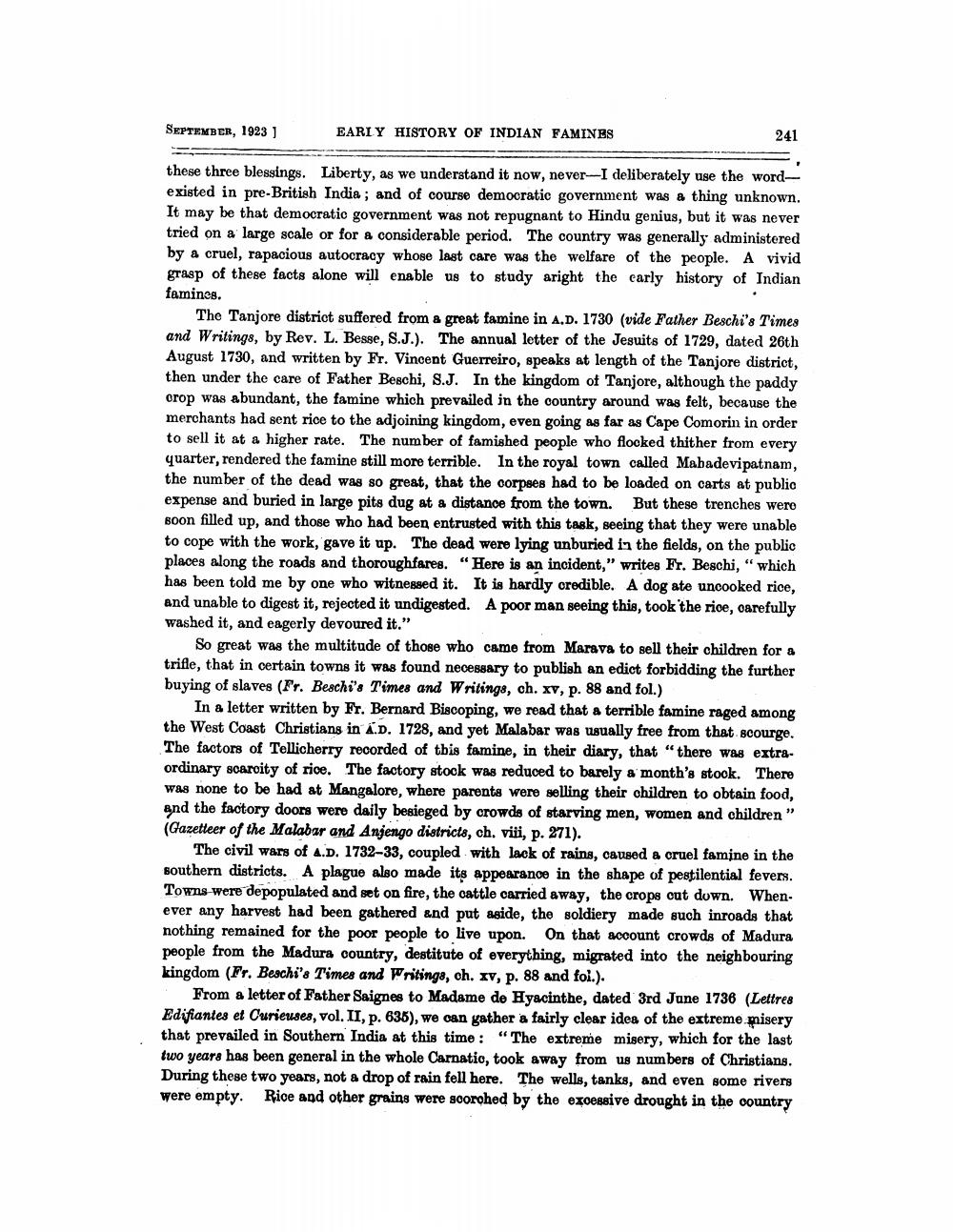________________
SEPTEMBER, 1923)
EARLY HISTORY OF INDIAN FAMINES
241
these three blessings. Liberty, as we understand it now, never-I deliberately use the wordexisted in pre-British India, and of course democratic government was a thing unknown. It may be that democratic government was not repugnant to Hindu genius, but it was never tried on a large scale or for a considerable period. The country was generally administered by a cruel, rapacious autocracy whose last care was the welfare of the people. A vivid grasp of these facts alone will enable us to study aright the early history of Indian famines.
The Tanjore district suffered from a great famine in A.D. 1730 (vide Father Beschi's Times and Writings, by Rev. L. Besse, S.J.). The annual letter of the Jesuits of 1729, dated 26th August 1730, and written by Fr. Vincent Guerreiro, speaks at length of the Tanjore district, then under the care of Father Beschi, S.J. In the kingdom of Tanjore, although the paddy orop was abundant, the famine which prevailed in the country around was felt, because the merchants had sent rice to the adjoining kingdom, even going as far as Cape Comorin in order to sell it at a higher rate. The number of famished people who flooked thither from every quarter, rendered the famine still more terrible. In the royal town called Mabadevipatnam, the number of the dead was so great, that the corpses had to be loaded on carts at public expense and buried in large pits dug at a distance from the town. But these trenches were soon filled up, and those who had been entrusted with this task, seeing that they were unable to cope with the work, gave it up. The dead were lying unburied in the fields, on the public places along the roads and thoroughfares. “Here is an incident," writes Fr. Beschi," which has been told me by one who witnessed it. It is hardly credible. A dog ate uncooked rice, and unable to digest it, rejected it undigested. A poor man seeing this, took the rioe, oarefully washed it, and eagerly devoured it."
So great was the multitude of those who came from Marava to sell their children for a trifle, that in certain towns it was found necessary to publish an edict forbidding the further buying of slaves (Fr. Beschi's Times and Writings, ch. xv, p. 88 and fol.)
In a letter written by Fr. Bernard Biscoping, we read that a terrible famine raged among the West Coast Christians in A.D. 1728, and yet Malabar was usually free from that scourge. The factors of Tellicherry reoorded of this famine, in their diary, that “there was extraordinary scarcity of rice. The factory stock was reduced to barely a month's stook. There was none to be had at Mangalore, where parents were selling their children to obtain food, and the factory doors were daily besieged by crowds of starving men, women and children" (Gazetteer of the Malabar and Anjengo districts, ch. viii, p. 271).
The civil wars of A.D. 1732-33, coupled with lack of rains, caused a cruel famine in the southern districts. A plague also made its appearance in the shape of pestilential fevers. Towns were depopulated and set on fire, the cattle carried away, the crops out down. When ever any harvest had been gathered and put aside, the soldiery made such inroads that nothing remained for the poor people to live upon. On that account crowds of Madura people from the Madura country, destitute of everything, migrated into the neighbouring kingdom (Fr. Beschi's Times and Pritings, ch. xv, p. 88 and fol.).
From a letter of Father Saignes to Madame de Hyacinthe, dated 3rd June 1736 (Lettres Edifiantes et Curieuses, vol. II, p. 636), we can gather a fairly clear idea of the extreme misery that prevailed in Southern India at this time : “The extreme misery, which for the last two years has been general in the whole Carnatic, took away from us numbers of Christians. During these two years, not a drop of rain fell here. The wells, tanks, and even some rivers were empty. Rice and other grains were soorohed by the excessive drought in the country




